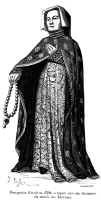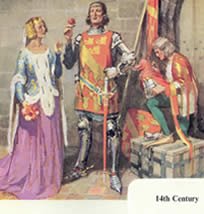Late medieval fashion peroid

For the medieval person, clothing and dress always had a special meaning. The symbolic aspects of a given garment, and not simply the utility functions such as protection, played a significant role in medieval society. Costumes composed a part of courtly life as well, their special meaning having been defined and refined by members of the aristocracy for their own use. The great changes in costumes of the fourteenth century, which can best be characterized by the spread of short upper garments among men, and the general trend towards tight-fitting dresses both in male and female clothing, can be traced in written, pictorial, and archeological sources.
This part of costume studies was—unfortunately—neglected for a long time. The first medievalists who dealt with this field, obtained great merits with the recording of costume data visible on standing monuments, ruins, museums, etc. Their main idea was that forms of costume
 s corresponded with architectural styles, and, as those, depended on morals. Thus, the late medieval costume styles were interpreted as "complicated and bizarre", and a close relationship was supposed between the "vertical and tight-fitting" costumes of the period and the flèches of the cathedrals, compared with, for instance, " Romanesque hieratism" and "Byzantine ornamental" style.
s corresponded with architectural styles, and, as those, depended on morals. Thus, the late medieval costume styles were interpreted as "complicated and bizarre", and a close relationship was supposed between the "vertical and tight-fitting" costumes of the period and the flèches of the cathedrals, compared with, for instance, " Romanesque hieratism" and "Byzantine ornamental" style.The trend towards greater extravagance in dress, found in the 11th -13th centuries, increases throughout this whole period. Several factors were at work pushing high fashion towards greater and greater consumption: increased exports from the East in the wake of The Crusades, increased production and improved quality of textiles in the West, the wealth of a rising urban tradesman class, and the sudden increased inherited personal wealth of the survivors of the Black Plague (1350-1400).

In Italy these factors operated at a peak because fine fabric production and importation was the cornerstone of the Northern Italian economy. Huge fortunes were made in the Florentine and Venetian city republics by merchants and manufacturers who had no lands or titles with which to claim nobility. These wealthy merchants sought out a way to buy the status that they craved. With fabric as their stock in trade they dressed more lavishly than the landed nobility, and spent fantastic sums on private and public art and architecture to gain social recognition.
Thanks to:
Colour-experience
Costumes.org
Ceu.hu

0 Comments:
Post a Comment
<< Home